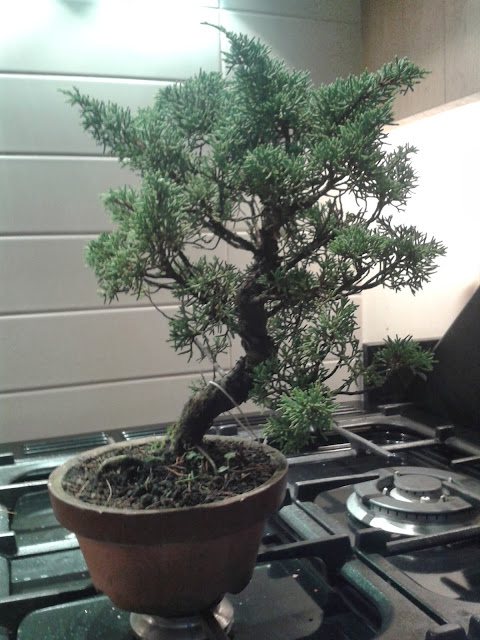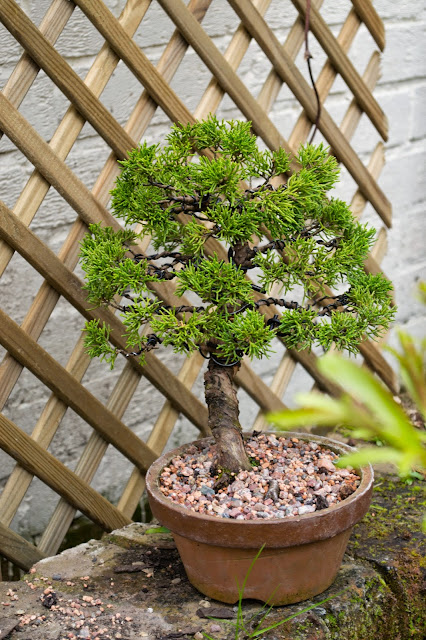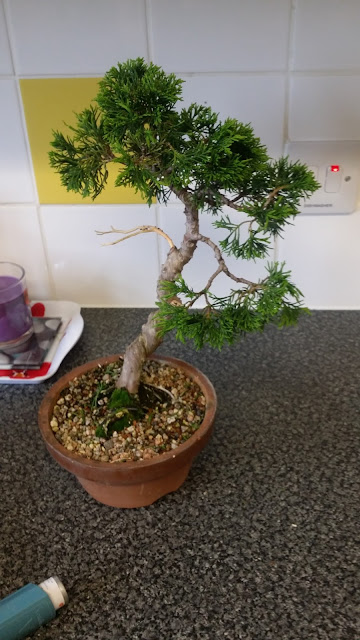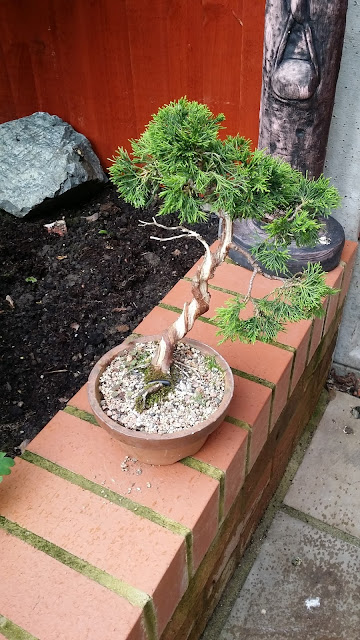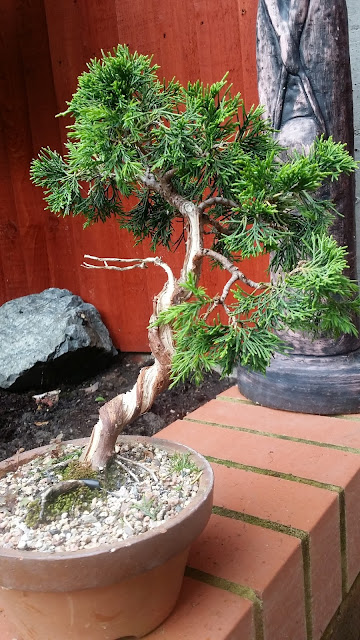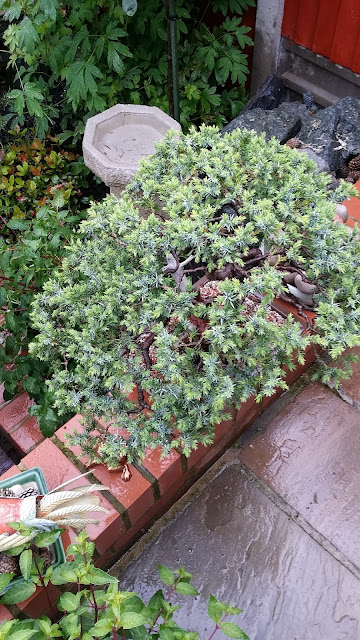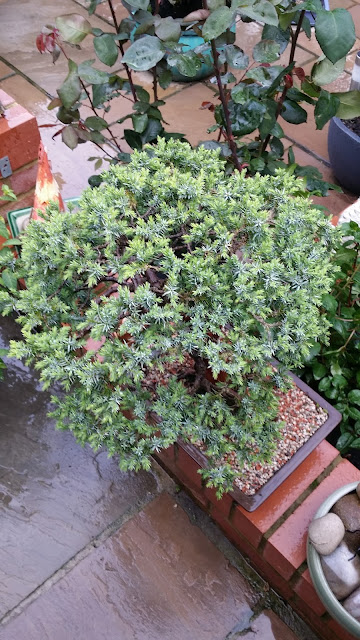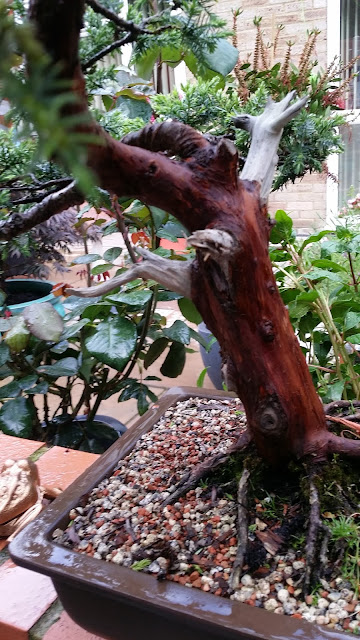It's all coming out now! Sorry about the poor picture quality...
DJ-BONSAI
A Bonsai blog interspersed with random musings of love and life
Thursday, 23 March 2017
Friday, 17 March 2017
Monday, 9 January 2017
Juniperus Squamata Pt 8 - The three year pruning cycle
Part 8! yoinks, it seems that I've learned how to drag out a topic to it's utter death! Well, it's 3 years (more or less to the day) since this tree had it's first full stripping down, and it is a very different tree now! It certainly needed a haircut as it was looking unruly and the inner needles were beginning to brown.
What a mess!
Thick and unruly, this foliage needs cutting right back or we'll lose the compact size of the silhouette, and end up with leggy growth where we want tighter ramification
So I set about stripping back again, leaving branches bifurcated. Last time I think it took around 18 hours to strip back - this time it took around 5 hours! I'm either getting faster or the tree is improving and maintenance is becoming easier.....
Here's the tree post haircut...
You'll see that ramification has improved since last year, the newer shoots have lignified nicely and bifurcation is evident almost everywhere - a stark contrast to our first thinning and pruning.
It's now super-simple to prune for balance, as I've now completely removed areas which were dominant. This should ensure a nicely balanced growth habit over the next 3 year cycle until it's ready for another full prune.
This time around I rewired for structure only, placing main branches and some secondary branching. I'm not sure I'm going to fine wire this time as I'm not sure that it's beneficial to the new shoots - it's easier to keep control of new growth with scissor pinching
I noticed that the right hand branch had lifted and wanted pulling down, so I set about creating some guys - this is preferable to wiring set as it can be left on almost indefinitely, rather than being taken off when the wire bites in....
I think that guys are far superior in so many respects, and offer way more longevity and flexibility than wiring
As always with this tree, it's hard to take a decent photo where the foliage doesn't just look messy, but you get an idea of the overall image below. Remember, I haven't fine wired for detail yet... I may change my mind but I'm toying with letting it go this time around and see if it makes any discernible difference to maintenance and refinement.
Sorry for the poor photo quality.
All in all I removed a washing up bowl full of foliage - probably over 50%, but unlike other junipers, this particular cultivar responds well to dramatic pruning - as long as you leave plenty of growing tips. This year was all about balance; first time around I wanted to remove a lot of foliage but left some weaker areas with a lot more foliage to try to get the plant to distribute energy to these areas and strengthen them up. I've pretty much nailed it, so a lot of further balancing has now been done and I'm extremely happy that it seems healthy and balanced all over.
Assuming I stay on top of the foliage as it pops over the next 2 seasons, this heavy prune wont need doing again until 2020.
I'm chuffed with how much easier it was this time and am now looking for more Squamatas to play with!
Thanks for reading,
Deano!
Tuesday, 3 January 2017
Material for ground growing is building up!
As you know I have recently acquired an allotment, the chronicles of which can be read HERE
Well, not much has been happening over there but I have been slowly building my stock and associate paraphernalia for planting in the spring.
Check out this amazing pallet which arrived at my workplace recently. the sides are completely removable, and fold down with metal hinges, it also has a lid if required.
However, to me, it looks like a box planter ready for newly collected material in the spring! it doesn't look it but it's actually a whopper - the width you can see nearest the front is wide enough to take a pallet truck. Just need to drill some holes and use some greenhouse mesh to cover the holes....
A couple of other bits too:
A nice ancient hawthorn I collected recently which is in dormancy:
gorgeous craggy bark and lovely wide basal flare(hard to tell from my crappy photo)....
Left to right: Hibiscus, collected from a hillside near Naples as a shoot over 30 years ago, and was left in a pot for the whole time - this was only repotted into the molar clay below last season.
Middle: trident maple - this is my main candidate for going in the ground and having a crack at a sumo over the next 15 years
right: field maple I *think*
You may be wondering what they are planted in, so I'll tell you; they are planted in pond baskets.
So why plant them in pond baskets you might be asking yourself? Well, I'll tell you!
One of the long term aims in bonsai is to generate a root ball of fine roots, and not long thick ones you'd normally associate with trees. Planting in the ground unfortunately has the side effect of promoting thick bulbous roots and normal pots do similarly.
Pond baskets however, have the amazing benefit of being super-free draining, and also self prune the roots as they grow. As the roots hit the edges of the basket they hit air and dry out, forcing the plant within to push out new fibrous roots further back in. This has the highly desirable effect of create a mass of fine feeder roots....perfect for eventually putting into a bonsai pot!
They are also bloody cheap and very convenient as they are generally hardwearing enough to re-use.
Anyway, back to the pics:
In no particular order, there are below - spruce , another hawthorn, Ash, spirea, cotoneaster, a couple more Larch, a couple of beech, blackthorn etc
and one more Hawthorn...
Pretty much all of this stuff is being ground planted in the spring, to get some trunks growing. I won't go into trunks now, but suffice to say it's a long, slow job but there are plenty of trees here which should give me some decent stuff to play with over the next ten years!
I've acquired a fair bit of it from a friend who left the country and was having a clearout. Ironically his move fell through, but he let me keep it anyway! (I'm still unsure it wasn't just a ruse to clear out some of the monstrous volume he had in his garden!)
Thanks for reading, more updates soon, including a cheeky little Silver Birch I collected near Windermere
Deano
Saturday, 19 November 2016
Friday, 18 November 2016
The Bonsai hunter.....
God I'm excited. Summer has come to a close and asides from the usual wire removal and bud work on a few of my trees, I there's not a lot let for me to do this year. The Junipers were repotted earlier in the year so won't be worked too hard. The big white pine was fully wired and will need wire removing in certain places, and bud selection.
However, bollocks to all that, this is the super-fun bit; I'm off to collect hawthorn material!
Following on from my last post, it seems widely accepted that Hawthorn are more successful collected in the Winter.
I've been hunting around the county over the past few months, going on long walks and speaking to landowners - and I've unearthed a few cracking sites. As a rule, hawthorn are fairly easy to find, but they are largely uninteresting; straight trunked with little or no taper and long uninterrupted sections. However, if you look in more challenging/inaccessible places, you can discover more interesting stuff...with rotting trunks, better basal flare, old cracked bark and if you are lucky, compacted growth from animal grazing/regular pruning
The first site is within a fairly commutable distance and has some basic Hawthorn material which I can start on... the kind of stuff you'd probably pay around £150-£250 on Kaizen...there's plenty of those.
Not a million miles from there is a thickly planted copse, with a dedicated hawthorn planting dating back around 40 years or so...and there are some far more interesting specimens there. From these I hope to grab a couple of interesting pieces, some with loads of natural deadwood and interesting bases.
But the site I'm most excited about is in a super chalky area and the material in question is evidently well over 100 years old, yet no higher than waist height. Nearly every Hawthorn on this wide open field has incredible nebari/trunk characteristics, compact twiggy growth and stunning, deep craggy bark. Not only this, it's pretty much the only example I've seen with such light coloured bark for this age... which I can only attribute to being in chalky soil for so long. You don't find stuff like this very often and it's taken me months of searching to find this!
I've identified one target tree to grab first which shouldn't present too much of a challenge - it's perfect for a literati style as it's trunk(quite unusually) corksrews and twists up, and the bark is wonderful.
I've identified one target tree to grab first which shouldn't present too much of a challenge - it's perfect for a literati style as it's trunk(quite unusually) corksrews and twists up, and the bark is wonderful.
I'm going armed with a basic set of tools:
Solid Steel Spade (half the work of a standard spade, although the trade-off is it's heavier to carry)
Cordless Reciprocating saw (got this compact version which is perfect for tackling tough roots with the least effort)
Hand reciprocating saw (for when the battery does on the cordless!)
Loppers for quick removal of larger branches
...plus Secateurs, Gaffer tape, Tarp material for wrapping the rootball, 3 tarp trugs, Strong gloves, Big Rucksack, string.....
I've also prepared for potting up at the other end...... I have 4.5l of sphagnum moss, pond baskets, bread baskets and enough materials to make bigger boxes if required. Also loads of Kyodama...Just a few litres of low-dust cat litter to go and I'm all set!
Bring it on!!!!!
Monday, 31 October 2016
Let's talk about collecting methods...
I originally asked this question here: http://weetrees.co.uk/phpBB3/viewtopic.php?f=5&t=15660
I wanted to ask the experienced collectors out there a couple of questions, which on paper seem to make sense, yet seem to contradict the "norm" when it comes to collecting.
Let's talk about hawthorn, as I've just come across a goldmine of them locally
I've spoken to some very experienced collectors and they all say to prune off the unwanted braches at point of collection, dig it up, pot it, voila. Normally speaking we then see a stump in a box/pot and wait for budding/shoots over the next season or two. We then nurse it and we take it very slowly and steadily.
However, lets take a moment to think about the time of year we are collecting. Why are we collecting in spring, just as buds are swelling? This is mainly, I believe, because the roots have sent all of the stored nutrients back up into the tree. This gives us a window of opportunity to dig it up, lose some root(which has already sent off it's stored energy anyway), and allow the tree to makes leaves, which will in turn sunlight into energy, and push it back down, facilitating new root growth. Fast forward 2-3 seasons or so and hopefully we'll have a fairly healthy tree which we could possibly start to work on.
Here's the bit I want to question:
Why not cut all unwanted branching off in the winter BEFORE the movement of sap?
Why are we allowing the tree to fill these branches with sap, and then chopping them off, losing most of the goodness the roots have sent up, and crippling the tree's resources before we've even started? Why wouldn't we prune it down in winter, then wait for the roots to send up that energy to dormant/latent buds and accelerate the healing process, not losing half/most of it at the collection time?
Surely what we'd then get is loads of new shoots everywhere, helping the tree to recover faster?
I'd really love to hear the thoughts of experienced collectors in particular on this one
I wanted to ask the experienced collectors out there a couple of questions, which on paper seem to make sense, yet seem to contradict the "norm" when it comes to collecting.
Let's talk about hawthorn, as I've just come across a goldmine of them locally
I've spoken to some very experienced collectors and they all say to prune off the unwanted braches at point of collection, dig it up, pot it, voila. Normally speaking we then see a stump in a box/pot and wait for budding/shoots over the next season or two. We then nurse it and we take it very slowly and steadily.
However, lets take a moment to think about the time of year we are collecting. Why are we collecting in spring, just as buds are swelling? This is mainly, I believe, because the roots have sent all of the stored nutrients back up into the tree. This gives us a window of opportunity to dig it up, lose some root(which has already sent off it's stored energy anyway), and allow the tree to makes leaves, which will in turn sunlight into energy, and push it back down, facilitating new root growth. Fast forward 2-3 seasons or so and hopefully we'll have a fairly healthy tree which we could possibly start to work on.
Here's the bit I want to question:
Why not cut all unwanted branching off in the winter BEFORE the movement of sap?
Why are we allowing the tree to fill these branches with sap, and then chopping them off, losing most of the goodness the roots have sent up, and crippling the tree's resources before we've even started? Why wouldn't we prune it down in winter, then wait for the roots to send up that energy to dormant/latent buds and accelerate the healing process, not losing half/most of it at the collection time?
Surely what we'd then get is loads of new shoots everywhere, helping the tree to recover faster?
I'd really love to hear the thoughts of experienced collectors in particular on this one
Tuesday, 9 August 2016
My ground planting project....
Things are moving in the ground planting project...take a look at the other blog for a look!
Wednesday, 20 July 2016
The sun, the heat and the effect on little trees
This past few days has been as warm as I can remember in this country. I do remember when I was around my late 20's working in London, when the heat reached nearly 32c. I remember the searing feel of it from spending just a few minutes and the sweaty tiring experience of being in an exposed office with no aircon.
Well, temperatures in my office yesterday exceeded 34c and I had a shirt and suit on. With no air-con.Yesterday was a miserable, shattering day of sweaty distraction and I figure it must have been just the same for the trees.
We are told that Japanese White Pine love the extremes, so I wasn't' at all worried about that one, and the Squamata is about as bulletproof as they come. Plus they are both in fairly large pots, which retain enough moisture for one day. They naturally prefer to dry out somewhat between waterings...they'll cope.
However, the thirsty boys of the Japanese Cherry & the White Wisteria are altogether different beasts.
These trees are VERY demanding water wise. The Wisteria is currently planted in a deep pot with a water tray in which the pot is partially submerged, and it still runs out every day. The Cherry just drinks for England on any given day(or is that Japan?).
My biggest concern though, is the Itoigawa which I worked heavily here, being in a very free draining mix. Again, Junipers much prefer to become almost dry between waterings, but the intense pounding of the sun over the past few days has affected it in other ways... I have noticed that the slimmest section of live vein which I recently worked(and hasn't yet had time to settle) is beginning to pull away from the heartwood. I think this is a case of the sun being so hot and continuous, it has literally dried the heartwood in the tree, right down to the Xylem.
It has been placed in a very sheltered spot and will be foliage sprayed twice a day to try to give it some help but I don't hold out much hope to be honest....
I love summer, but regret not offering this tree protection for a lot longer against the very harshest elements...
We live and learn I guess....
Well, temperatures in my office yesterday exceeded 34c and I had a shirt and suit on. With no air-con.Yesterday was a miserable, shattering day of sweaty distraction and I figure it must have been just the same for the trees.
We are told that Japanese White Pine love the extremes, so I wasn't' at all worried about that one, and the Squamata is about as bulletproof as they come. Plus they are both in fairly large pots, which retain enough moisture for one day. They naturally prefer to dry out somewhat between waterings...they'll cope.
However, the thirsty boys of the Japanese Cherry & the White Wisteria are altogether different beasts.
These trees are VERY demanding water wise. The Wisteria is currently planted in a deep pot with a water tray in which the pot is partially submerged, and it still runs out every day. The Cherry just drinks for England on any given day(or is that Japan?).
My biggest concern though, is the Itoigawa which I worked heavily here, being in a very free draining mix. Again, Junipers much prefer to become almost dry between waterings, but the intense pounding of the sun over the past few days has affected it in other ways... I have noticed that the slimmest section of live vein which I recently worked(and hasn't yet had time to settle) is beginning to pull away from the heartwood. I think this is a case of the sun being so hot and continuous, it has literally dried the heartwood in the tree, right down to the Xylem.
It has been placed in a very sheltered spot and will be foliage sprayed twice a day to try to give it some help but I don't hold out much hope to be honest....
I love summer, but regret not offering this tree protection for a lot longer against the very harshest elements...
We live and learn I guess....
Tuesday, 28 June 2016
Ground growing and planting...
I currently have no garden, which is tricky as an avid Bonsaista and blogger of things related to horticulture. I left that behind when I left my joyless control-freak of an ex-partner.
*shudder*
However, I soon came to realise that I couldn't really survive without a garden; living in a flat without one wasn't helping... so I applied for an allotment. A place of quiet contemplation, hard work and personal endeavour, sprinkled with the joy of actually growing stuff.
The waiting lists are quite something in the Stevenage area but I felt that in order to get a 5 year headstart on buying a new place, I could work an allotment for that period and get some material in the ground. By the time I buy a new place I should have some half decent material to take with me.
I also quite fancy planting and growing my own vegetables. So rather that litter my bonsai blog with tales of Legumes and Brassicas, I started my very own allotment blog. You can find it here;
A Seedy Plot
I won't ruin the plot(hur hur) line, but I will say that there will be some cross contamination betweenblogs, as I intend to start some Blaaw Juniper, and Japanese White / Japanese Black Pine material from fairly early stage and see if I can whip up some decent material with my new found space.
I will of course be developing any new material I come across in the meantime, so expect updates from both or either blog to this regard. I will try and keep this blog purely bonsai related, but might steer you over to the other one now and again where technique and results are worth noting.
I hope you enjoy reading both.
*shudder*
However, I soon came to realise that I couldn't really survive without a garden; living in a flat without one wasn't helping... so I applied for an allotment. A place of quiet contemplation, hard work and personal endeavour, sprinkled with the joy of actually growing stuff.
The waiting lists are quite something in the Stevenage area but I felt that in order to get a 5 year headstart on buying a new place, I could work an allotment for that period and get some material in the ground. By the time I buy a new place I should have some half decent material to take with me.
I also quite fancy planting and growing my own vegetables. So rather that litter my bonsai blog with tales of Legumes and Brassicas, I started my very own allotment blog. You can find it here;
A Seedy Plot
I won't ruin the plot(hur hur) line, but I will say that there will be some cross contamination betweenblogs, as I intend to start some Blaaw Juniper, and Japanese White / Japanese Black Pine material from fairly early stage and see if I can whip up some decent material with my new found space.
I will of course be developing any new material I come across in the meantime, so expect updates from both or either blog to this regard. I will try and keep this blog purely bonsai related, but might steer you over to the other one now and again where technique and results are worth noting.
I hope you enjoy reading both.
Wednesday, 22 June 2016
Itoigawa juniper..imported pt2 - progression....
Let's fast forward to today from this original post:
http://dj-bonsai.blogspot.co.uk/2013/12/another-itoigawa-imported-material.html
Here was the first thinning and spreading out of branches in March 2014 to allow maximum light in, plus a sorting of roots to get rid of that shitty Akadama which the roots were welded in to. Surprisingly, we lost over 60% of the roots due to that horrible shit, but it bounced back fine.
http://dj-bonsai.blogspot.co.uk/2013/12/another-itoigawa-imported-material.html
Dec 2013
Here was the first thinning and spreading out of branches in March 2014 to allow maximum light in, plus a sorting of roots to get rid of that shitty Akadama which the roots were welded in to. Surprisingly, we lost over 60% of the roots due to that horrible shit, but it bounced back fine.
March 2014
2015 - summer: Literati starting to take shape. I think that lower right branch could eventually go, but easy does it. Need to start to compact that foliage but don't want to stress the tree too much with pinching. Let's let it adjust to losing that big branch(shown here stripped back)
Summer 2015
Here's where I have a gap in the photo series, but I basically stripped back the bark from under the removed branch and followed it all the way down to the base in a spiral....
Fast forward to June 2016:
Time to widen those deadwood spirals, and apply limesulphur.
(note the small amount of juvenile foliage on that lower branch, just on one side. I think we've got away with it here, we did a lot of work to this tree over the last 2.5 years)
Summer 2016
Note that I haven't wired up the foliage at all. Itoigawas are easy to style once the leg work is done, so for now I'm just getting those live veins as separate from the deadwood as possible and digging into the deadwood to give it some character.
Pulling back the live veins this much might result in a little dieback in the foliage, but tbh, I'm not too worried, there isn't really a branch on it that I don't mind losing, as it has so many options to choose from...
Going to leave it to grow pretty much freely for the rest of the year, to let those live veins settle again. I'll keep an eye on any long extensions to ensure it stays fairly compact, and feed with naruko / seaweed extract. It's getting quite close now, which means I can start thinking about a pot for next spring....
Juniperus Squamata Meyeri pt7b
Subscribe to:
Comments (Atom)
































